Canopy fractal
World's simplest fractal tool
This utility lets you draw custom and colorful canopy fractals. You can change more than a dozen different parameters to create the most pretty trees. You can adjust the bending angle of the right and left branches and set the ratio of their length and thickness from iteration to iteration. For the trunk, you can set its starting width and the growth direction. Optionally, you can disable drawing the trunk altogether and just start with the branches. For the fractal, you can specify the canvas size and add padding around the canopy. As a bonus, you can draw the background and the tree in gradient colors. Fun fact – the pulmonary system used by humans to breathe resembles a fractal canopy. Created by fractal fans from team Browserling. Fractabulous!
announcement
a new site!
We just launched a new site – Online List Tools – utilities for working with lists. Check it out!
A link to this tool, including input, options and all chained tools.
Can't convert.
What is a canopy fractal?
learn more about this tool
This online browser-based tool illustrates binary fractal trees and their canopies. A fractal canopy is one of many fractals in the family of the tree-like fractals, such as Pythagoras fractal and V-tree. Just like a regular tree, a fractal tree is created by splitting a line segment in two at a certain angle (or two angles – one for each new segment) and with a certain scale factor (or two factors – also one for each new segment). Then each of the two new segments is split again, and again (and again to infinity). If you're thinking in terms of an analogy with a regular tree, then the first line segment is the trunk of the tree, the new split segments are branches, and the final segments at n-th iteration are twigs (also called branch tips). In our tool, each branch can have its own angle that it makes with the trunk. Our tool also has two scale factors that reduce the width and length of the segments in every next iterative step. With every step, twice as many branches bifurcate and the number of branches doubles. We can find that the n-th recursion the tree consists of 2ⁿ - 1 line segments (including the trunk of the tree). If the angle, scale length, and scale width factors of both branches are the same, then we get a symmetric fractal canopy (also known as a symmetric binary fractal tree). Such trees have a left-right symmetry, with the affine hull as the line of reflection. A self-contacting symmetric binary fractal tree has self-intersection but no actual branch crossings. For a given branching angle, there is a unique scaling ratio, such that the corresponding tree is self-contacting. If the branch scale factor is equal to the conjugate of the golden ratio value Φ = 1/φ (where φ = 1.6180339…), then the fractal is called the golden fractal tree, golden canopy or just the golden tree. There are exactly four self-contacting golden trees for which branching angles are 60°, 108°, 120°, and 144°. Angles 90° and 135° are called critical angles of the canopy fractal because at the 90° angle the branches fill the shape of a rectangle, and at the 135° angle, they fill a triangle form. Some combinations of parameters create other well-known fractals, such as Hausdorff tree, Cantor set, and Koch curve, as well as classical geometrical polygons, such as the pentagon and decagon. Mind blowing and ingenious at the same time, or as we love to say – fractabulous!
Canopy fractal examples
Click to useRegular Canopy Fractal
In this example, we generate the textbook version of the canopy fractal tree. It's symmetric as both of its branches bend at an angle equal to 2π/11 ≈ 16 degrees and both the length and width ratios are 0.75. For the gradient, we've chosen to color each segment level in its own color. The tree starts with the harlequin-green color in the trunk and ends with the blush-pink color in the tips. We bifurcate the tree for 8 iterations and draw it on a cerise-red to Christelle-pink color gradient canvas.
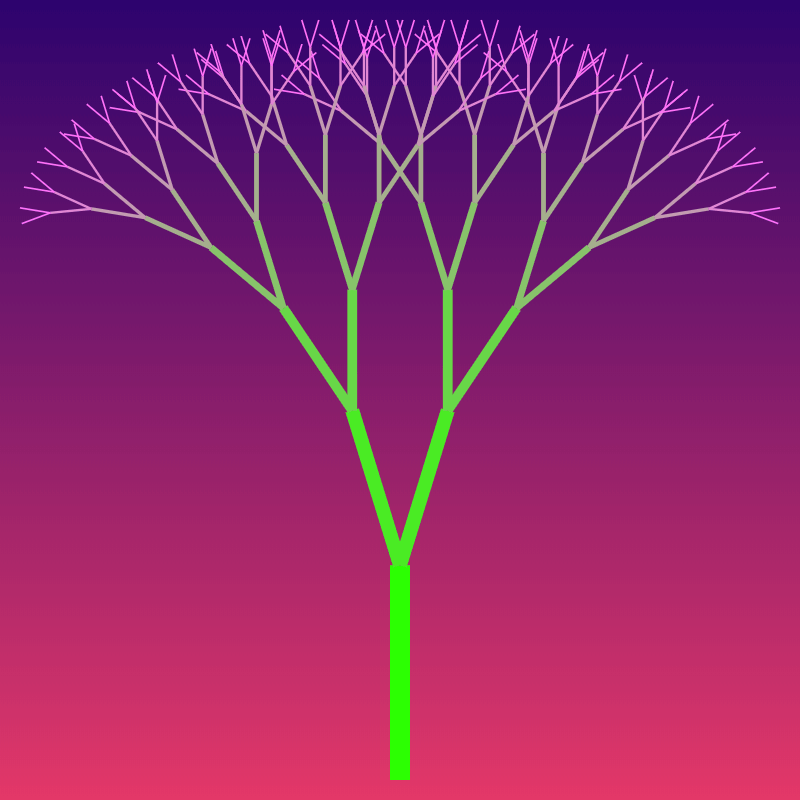
Required options
Tree growth direction.
Left angle.
Right angle.
Left branch length factor.
Right branch length factor.
Left branch width factor.
Right branch width factor.
Canopy fractal's trunk width.
Draw the tree without a trunk.
Number of branch levels.
(Iterations.)
Space width.
Space height.
Padding around the canopy.
Branch gradient (from color).
Branch gradient (to color).
Background gradient (from color).
Background gradient (to color).
Wavy Tree Fractal
This example sets different bending angles for the segments and as a result, we get a wave-like asymmetrical fractal tree. The left rotation angle is 20 degrees and the right is 90 degrees. It also sets the length factor to 0.7 and the width factor to 0.79. It uses a Portofino-yellow to hit-pink gradient for the background and blue to black gradient for the tree that is applied in the tree's growth direction.
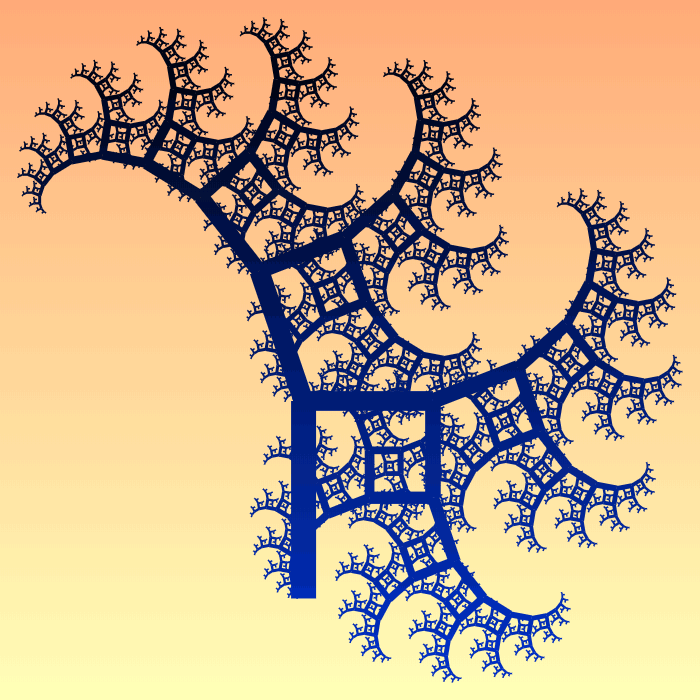
Required options
Tree growth direction.
Left angle.
Right angle.
Left branch length factor.
Right branch length factor.
Left branch width factor.
Right branch width factor.
Canopy fractal's trunk width.
Draw the tree without a trunk.
Number of branch levels.
(Iterations.)
Space width.
Space height.
Padding around the canopy.
Branch gradient (from color).
Branch gradient (to color).
Background gradient (from color).
Background gradient (to color).
Curly Tree Fractal
In this example, we draw a canopy that mildly curls in on itself on the right side from below. The angles make 30 and 60 degrees with the direction of the trunk. We generate the tree from a 16-pixel thick trunk and reduce its thickness 0.81 times in every recursion. The lengths of the left and right branches are contracted differently – the left branch decreases by the factor of 0.65 and the right branch by the factor of 0.75. As the right side shrinks slower than the left side, we get a curly tree. We generate 12 recursions on an 800x800 pixel canvas and apply a yellow-blue gradient for the tree from the trunk to the twigs.
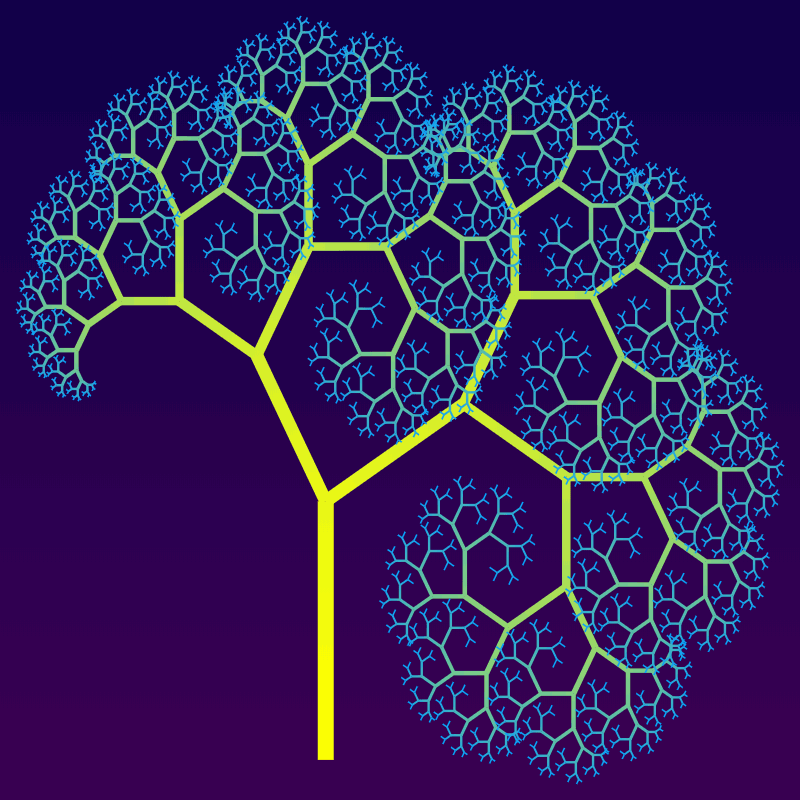
Required options
Tree growth direction.
Left angle.
Right angle.
Left branch length factor.
Right branch length factor.
Left branch width factor.
Right branch width factor.
Canopy fractal's trunk width.
Draw the tree without a trunk.
Number of branch levels.
(Iterations.)
Space width.
Space height.
Padding around the canopy.
Branch gradient (from color).
Branch gradient (to color).
Background gradient (from color).
Background gradient (to color).
Dragonfly Canopy Fractal
In this example, we use a very large bifurcation angle of 345 degrees for the right branch and a right 90-degree angle for the left branch. This makes the fractal heavily tilt to the left. With 12 iteration steps, this behavior makes the branches resemble the wings of a dragonfly. To fit the tree, we have increased the height of the image to 1000 pixels and width to 800 pixels. We fill individual segments with a gradient from selective-yellow color at the ground level to green at the top level.
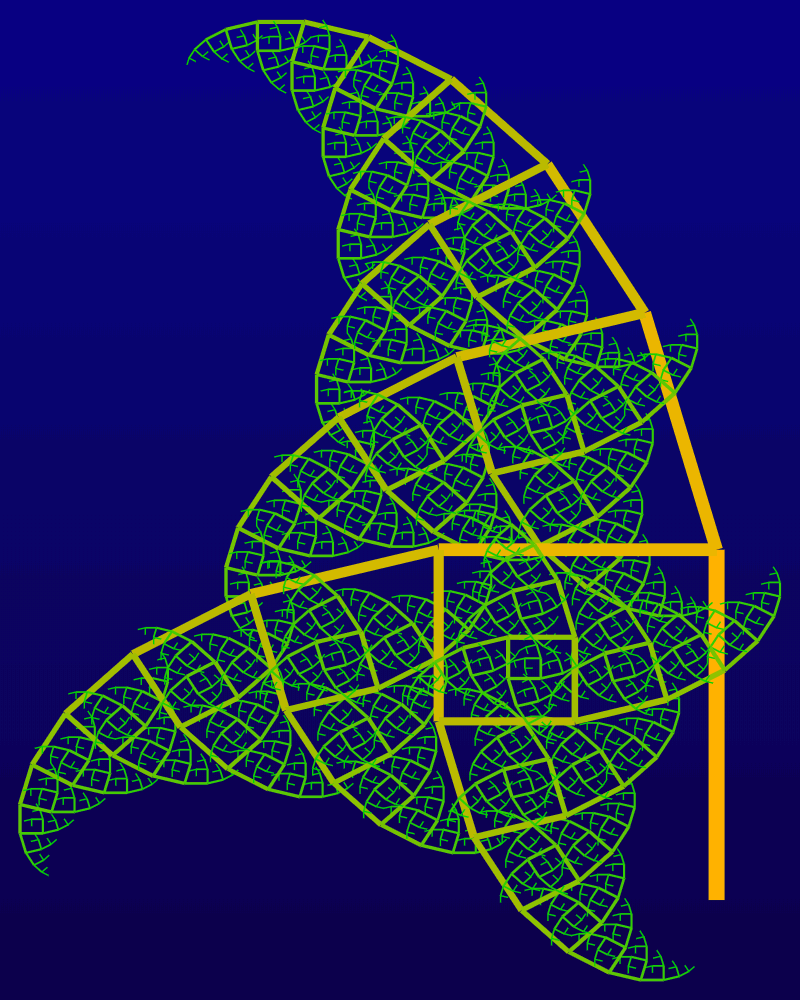
Required options
Tree growth direction.
Left angle.
Right angle.
Left branch length factor.
Right branch length factor.
Left branch width factor.
Right branch width factor.
Canopy fractal's trunk width.
Draw the tree without a trunk.
Number of branch levels.
(Iterations.)
Space width.
Space height.
Padding around the canopy.
Branch gradient (from color).
Branch gradient (to color).
Background gradient (from color).
Background gradient (to color).
Canopy H-tree Fractal
This example generates a tree with the right angles for both branches. The right angle is the critical angle for a canopy fractal as at this angle it turns in a space-filling fractal and the tree can completely fill a square with its branches. By adjusting the bifurcation scale factors of the curve, we can find values that make the branches not overlap one another, and we get the Hausdorff fractal (also known as the H-tree). We run the iterations for 11 stages and get 2¹¹ - 1 = 2048 - 1 = 2047 segments.
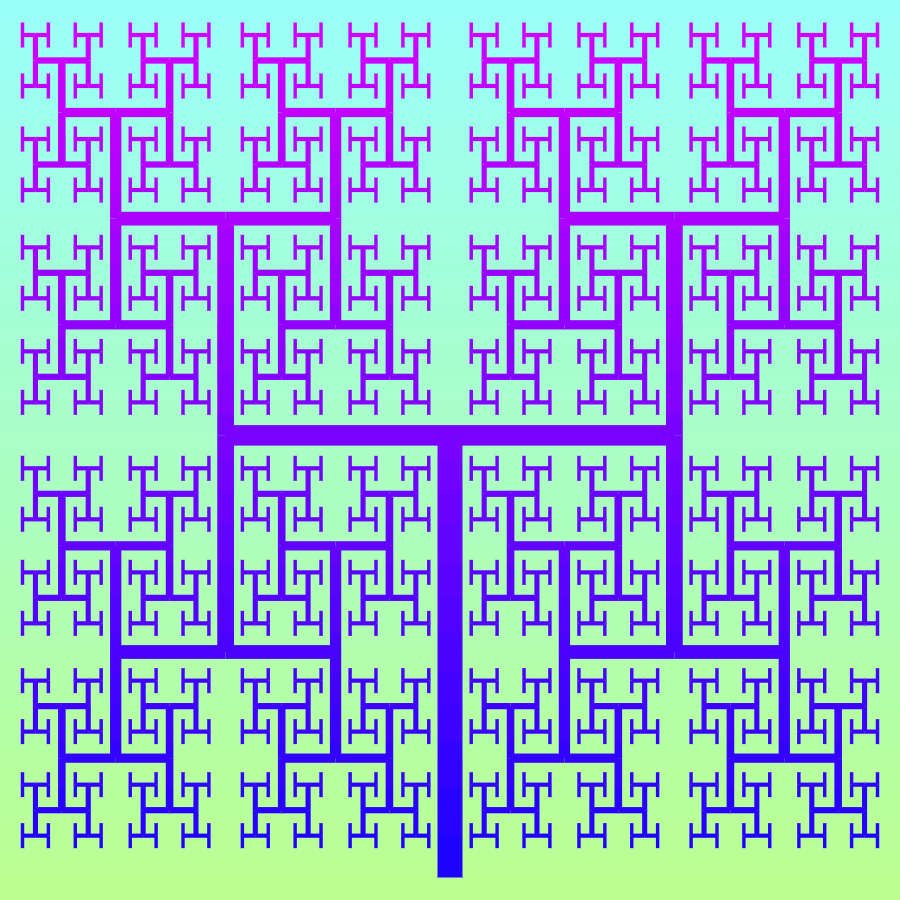
Required options
Tree growth direction.
Left angle.
Right angle.
Left branch length factor.
Right branch length factor.
Left branch width factor.
Right branch width factor.
Canopy fractal's trunk width.
Draw the tree without a trunk.
Number of branch levels.
(Iterations.)
Space width.
Space height.
Padding around the canopy.
Branch gradient (from color).
Branch gradient (to color).
Background gradient (from color).
Background gradient (to color).
Canopy Dragon Fractal
In this example, the canopy looks more like a dragon fractal than a tree fractal. This is due to well-chosen angles for branches (45 and 120 degrees), as well as length scale factors (0.75 and 0.6). We have also activated the "Skip the Trunk" option to make the fractal look more like a dragon. The result that you see is generated via 13 iterative loops and the color gradient we have chosen to fill the curve is lipstick-pink to white.
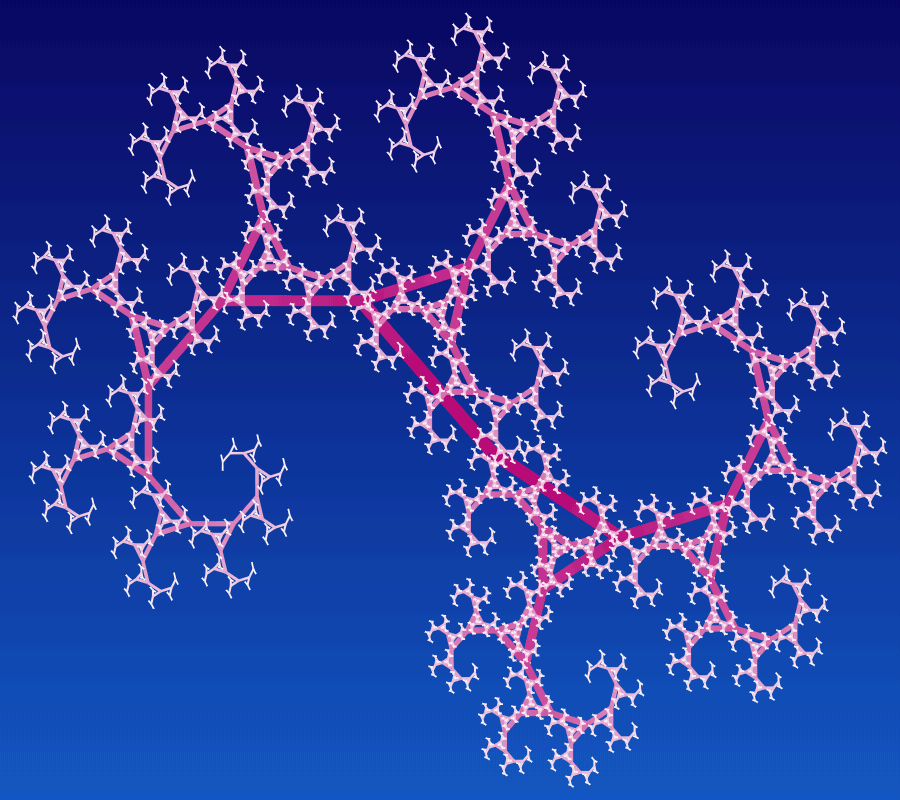
Required options
Tree growth direction.
Left angle.
Right angle.
Left branch length factor.
Right branch length factor.
Left branch width factor.
Right branch width factor.
Canopy fractal's trunk width.
Draw the tree without a trunk.
Number of branch levels.
(Iterations.)
Space width.
Space height.
Padding around the canopy.
Branch gradient (from color).
Branch gradient (to color).
Background gradient (from color).
Background gradient (to color).
Golden 60 Tree
This is an example of a symmetric binary self-contacting golden fractal tree of 14th order. Let's dissect the meaning of all words used in the title. First, it's symmetric because we use the same bending angle for all branches (equal to 60 degrees). It's binary because it has two branches (there are also other canopies and trees with more branches). Then, it's self-contracting as the twig tips of the left and right branches touch but do not overlay. It's also golden as the branching factor is equal to the value of the golden ratio conjugate Φ = 1/φ = 0.618… (which, surprisingly is also equal to φ-1). Finally, it's the 14th order as it has been iterated 14 times. If you look closely, you can see that the curve on the tree between the rightmost top point and the leftmost top forms a golden Koch curve. But wait, there's more! If you look even more carefully, you'll spot that there's a golden Cantor set hanging in there. The top points of this tree form a middle Cantor set, as is the case for all other self-contacting trees with branching angle less than 135 degrees.
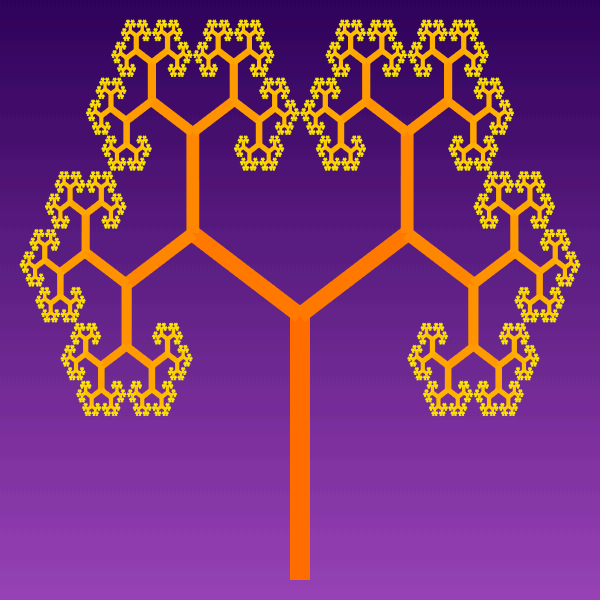
Required options
Tree growth direction.
Left angle.
Right angle.
Left branch length factor.
Right branch length factor.
Left branch width factor.
Right branch width factor.
Canopy fractal's trunk width.
Draw the tree without a trunk.
Number of branch levels.
(Iterations.)
Space width.
Space height.
Padding around the canopy.
Branch gradient (from color).
Branch gradient (to color).
Background gradient (from color).
Background gradient (to color).
Golden 120 Tree
This example also generates a golden self-contacting canopy but here the branch angle is 120 degrees. This tree is filled with an infinite amount of equilateral triangles. One equilateral triangle that you can immediately spot is the smallest triangle that bounds the fractal. The others are hidden in the branches and along the branches. As with the golden 60 canopy (previous example), the top twig points form a hidden Cantor fractal. You can also tile a hexagon with six copies of the canopy as well as create a variation of a Sierpinski triangle with three copies. Last but not least, this fractal also looks like a futuristic lamp post, so if you're designing the next future city, don't forget to credit us for the idea!
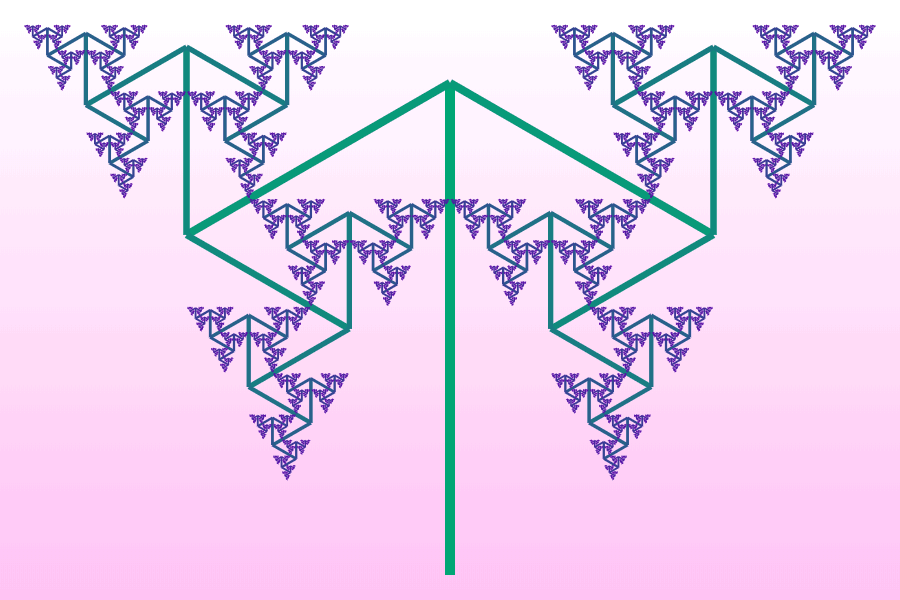
Required options
Tree growth direction.
Left angle.
Right angle.
Left branch length factor.
Right branch length factor.
Left branch width factor.
Right branch width factor.
Canopy fractal's trunk width.
Draw the tree without a trunk.
Number of branch levels.
(Iterations.)
Space width.
Space height.
Padding around the canopy.
Branch gradient (from color).
Branch gradient (to color).
Background gradient (from color).
Background gradient (to color).
Golden Koch Curve
In this example, we demonstrate a remarkable variation of a golden self-contacting tree. If the branching angle is 144 degrees, then the tip points of the tree produce the golden Koch fractal. To make the illustration pretty, we turn the fractal upside down, exclude the trunk, and expand the width of the image so that the Koch fractal can be better seen. If four copies of this tree are rotated around the bottom of the trunk with angles that are multiples of 72, then we can also create a golden Koch snowflake.
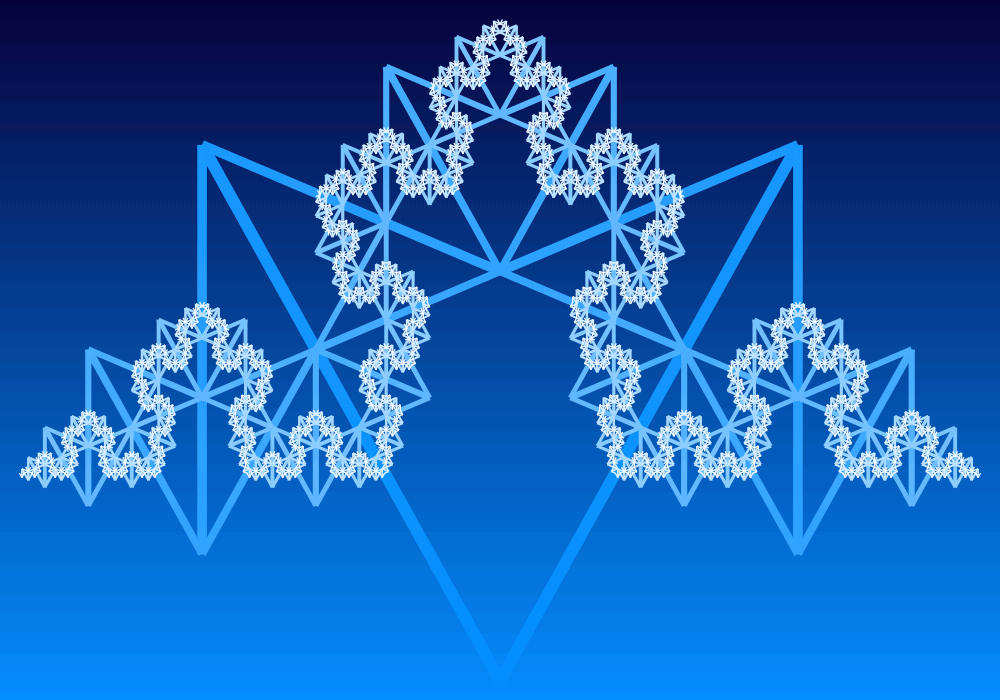
Required options
Tree growth direction.
Left angle.
Right angle.
Left branch length factor.
Right branch length factor.
Left branch width factor.
Right branch width factor.
Canopy fractal's trunk width.
Draw the tree without a trunk.
Number of branch levels.
(Iterations.)
Space width.
Space height.
Padding around the canopy.
Branch gradient (from color).
Branch gradient (to color).
Background gradient (from color).
Background gradient (to color).
Chinese Dragon Fractal
In this example, we use the following properties for the left and right branches. Left branch: bending angle – 45 degrees, scale factor – 0.7, width factor – 0.83. Right branch: bending angle – 190 degrees, scale factor – 0.6, width factor – also 0.83. With these parameters, the branches of the tree closely twist together, only slightly sprouting to the sides. By generating only 13 iteration steps, we see that the Chinese dragon curve emerges (also known as East Asian dragon). We decorate it with a white-blue gradient flame.
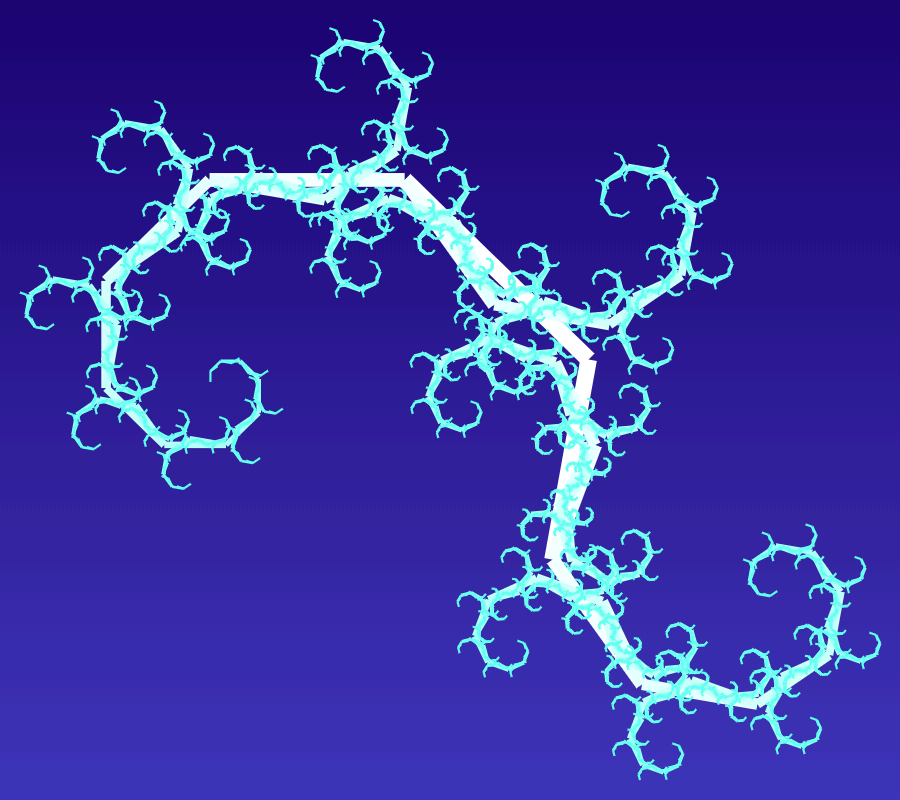
Required options
Tree growth direction.
Left angle.
Right angle.
Left branch length factor.
Right branch length factor.
Left branch width factor.
Right branch width factor.
Canopy fractal's trunk width.
Draw the tree without a trunk.
Number of branch levels.
(Iterations.)
Space width.
Space height.
Padding around the canopy.
Branch gradient (from color).
Branch gradient (to color).
Background gradient (from color).
Background gradient (to color).
Square Dragon Fractal
This example generates a square dragon fractal on a rectangular canvas of size 800 by 1000 pixels, with a light gradient from hint-of-green to periwinkle color. It sets the bending angles of the branches to 190 and 90 degrees and sets their scale proportions to 0.6 and 0.75 respectively. It turns the fractal to the left side, removes the padding, and doesn't draw the first segment.
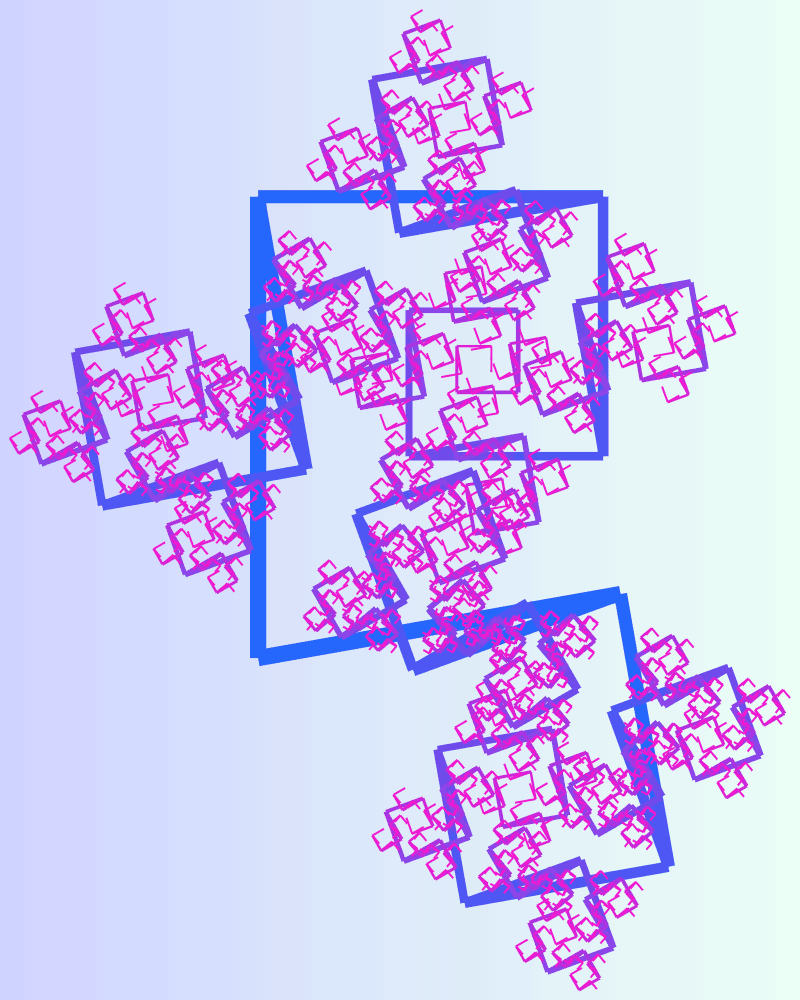
Required options
Tree growth direction.
Left angle.
Right angle.
Left branch length factor.
Right branch length factor.
Left branch width factor.
Right branch width factor.
Canopy fractal's trunk width.
Draw the tree without a trunk.
Number of branch levels.
(Iterations.)
Space width.
Space height.
Padding around the canopy.
Branch gradient (from color).
Branch gradient (to color).
Background gradient (from color).
Background gradient (to color).
Foamy Canopy
The canopy of this fractal twists so much that it creates a lot of bubble-like structures. Originally, this fractal had no name, so we called it the foamy fractal tree, or foamy canopy for short. To create the bubble effect, we use 72 degrees for the left branch and 188 degrees for the right branch. The reduction factors for both branches is the same. The length reduction factor is equal to 0.69 and the width reduction factor is equal to 0.78. We recurse 13 times and use an azure to white gradient from the trunk to tips.
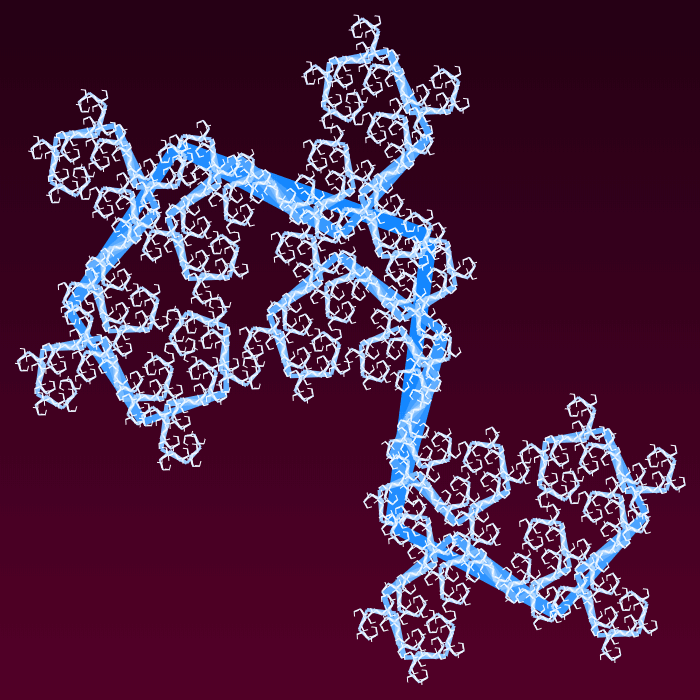
Required options
Tree growth direction.
Left angle.
Right angle.
Left branch length factor.
Right branch length factor.
Left branch width factor.
Right branch width factor.
Canopy fractal's trunk width.
Draw the tree without a trunk.
Number of branch levels.
(Iterations.)
Space width.
Space height.
Padding around the canopy.
Branch gradient (from color).
Branch gradient (to color).
Background gradient (from color).
Background gradient (to color).
Pro tips
Master online fractal tools
You can pass options to this tool using their codes as query arguments and it will automatically compute output. To get the code of an option, just hover over its icon. Here's how to type it in your browser's address bar. Click to try!
https://onlinefractaltools.com/draw-canopy-fractal?&left-angle=16&right-angle=16&left-length-factor=0.75&right-length-factor=0.75&left-width-factor=0.7&right-width-factor=0.7&iterations=8&width=800&height=800&individual-segment-gradient=true&line-from-color=%232cff02&line-to-color=%23ff72f6&background-from-color=%23e33869&background-to-color=%232c036e&line-width=20&padding=10&direction=up&skip-trunk=false
All fractal tools
Quickly draw a custom McWorter dendrite fractal.
Quickly draw a custom canopy tree fractal.
Quickly draw a custom Gosper fractal.
Quickly draw a custom Z-order fractal.
Quickly draw a custom Hilbert fractal.
Quickly draw a custom binary v-fractal.
Quickly draw a custom Peano fractal.
Quickly draw a custom Heighway dragon fractal.
Quickly draw a custom twin dragon Heighway fractal.
Quickly draw a custom Heighway nonadragon fractal.
Quickly draw a custom Koch fractal.
Quickly draw a custom triflake fractal.
Quickly draw a custom Sierpinski triangle fractal.
Quickly draw a custom Sierpinski pentagon fractal.
Quickly draw a custom Sierpinski hexagon fractal.
Quickly draw a custom Sierpinski polygon fractal.
Quickly draw a custom Moore fractal.
Quickly draw a custom Cantor comb fractal.
Quickly draw a custom Cantor dust fractal.
Quickly draw a custom Levy fractal curve.
Quickly draw a custom ice fractal.
Quickly draw a custom Pythagoras tree fractal.
Quickly draw a custom t-square fractal.
Quickly draw a custom Hausdorff tree fractal.
Coming soon
These fractal tools are on the way
Generate a Hilbert Sequence
Walk the Hilbert fractal and enumerate its coordinates.
Generate a Peano Sequence
Walk the Peano fractal and enumerate its coordinates.
Generate a Moore Sequence
Walk the Moore fractal and enumerate its coordinates.
Generate a Hilbert String
Encode the Hilbert fractal as a string.
Generate a Peano String
Encode the Peano fractal as a string.
Generate a Moore String
Encode the Moore fractal as a string.
Generate a Cantor String
Encode the Cantor set as a string.
Generate a Dragon String
Encode the Heighway Dragon as a string.
Generate a Sierpinski String
Encode the Sierpinski fractal as a string.
Sierpinski Pyramid
Generate a Sierpinski tetrahedron (tetrix) fractal.
Cantor's Cube
Generate a Cantor's cube fractal.
Menger Sponge
Generate a Sierpinski-Menger fractal.
Jerusalem Cube
Generate a Jerusalem cube fractal.
Mosely Snowflake
Generate a Jeaninne Mosely fractal.
Mandelbrot Tree
Generate a Mandelbrot tree fractal.
Barnsey's Tree
Generate a Barnsley's tree fractal.
Barnsey's Fern
Generate a Barnsley's fern fractal.
Binary Fractal Tree
Generate a binary tree fractal.
Ternary Fractal Tree
Generate a ternary tree fractal.
Dragon Fractal Tree
Generate a dragon tree fractal.
De Rham Fractal
Generate a de Rham curve.
Takagi Fractal
Generate a Takagi-Landsberg fractal curve.
Peano Pentagon
Generate a Peano pentagon fractal curve.
Tridendrite Fractal
Generate a tridendrite fractal curve.
McWorter's Pentigree
Generate a Pentigree fractal curve.
McWorter's Lucky Seven
Generate a lucky seven fractal curve.
Eisenstein Fractions
Generate an Eisenstein fractions fractal curve.
Bagula Double V
Generate a Bagula double five fractal curve.
Julia Set
Generate a Julia fractal set.
Mandelbrot Set
Generate a Mandelbrot fractal set.
Mandelbulb Fractal
Generate a Mandelbulb fractal.
Mandelbox Fractal
Generate a Mandelbox fractal.
Buddhabrot Fractal
Generate a Buddhabrot fractal.
Burning Ship Fractal
Generate a Burning Ship fractal.
Toothpick Fractal
Generate a toothpick sequence fractal.
Ulam-Warburton Fractal
Generate an Ulam-Warburton fractal curve.
ASCII Fractal
Generate an ASCII fractal.
ANSI Fractal
Generate an ANSI fractal.
Unicode Fractal
Generate a Unicode fractal.
Emoji Fractal
Generate an emoji fractal.
Braille Fractal
Generate a braille code fractal.
Audio Fractal
Generate a fractal in audio form.
Draw a Pseudofractal
Create a fractal that looks like one but isn't a fractal.
Convert Text to a Fractal
Generate a fractal from any text.
Convert a String to a Fractal
Generate a fractal from a string.
Convert a Number to a Fractal
Generate a fractal from a number.
Merge Two Fractals
Join any two fractals together.
Draw a Random Fractal
Create a completely random fractal.
Iterate an IFS
Set up an arbitrary IFS system and iterate it.
Run IFS on an Image
Recursively transform an image using IFS rules.
Iterate an ICAF
Run infinite compositions of analytic functions.
Generate a Fractal Landscape
Create a surface that mimics a natural terrain.
Generate a Brownian Surface
Create a fractal surface via Brownian motion.
Generate a Self-similar Image
Apply fractal algorithms on your image and make it self-similar.
Find Fractal Patterns in Images
Find fractal patterns in any given image.
Find Fractal Patterns in Text
Find fractal patterns in any given text.
Find Fractal Patterns in Numbers
Find fractal patterns in any given number.
Fill a Plane with Fractals
Tessellate a plane with fractals.
Run a Cellular Automaton
Run a cellular automaton with custom rules.
Play Game of Life
Play Conway's Game of Life on an infinite grid.
Subscribe!
Never miss an update
Cool!
Notifications
We'll let you know when we add this tool
Cool!
